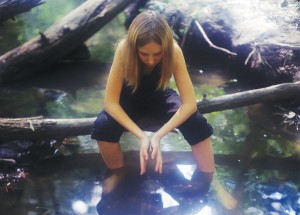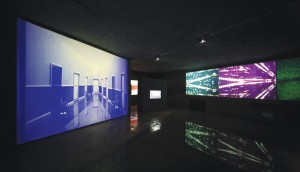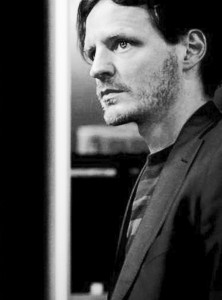« Face to Face
Staging Video and Film
A Conversation between Tim White-Sobieski and Hans Op de Beeck
Visual artists Tim White-Sobieski (USA) and Hans Op de Beeck (Belgium) have accepted ARTPULSE’s invitation to discuss their new media and film practices and the challenges of both current technology and the art market.
Tim White-Sobieski -Alright, Hans, let’s pretend for a second we do not have these 15+ years of burden and experience in film production; let’s pretend we would have to start from scratch in 2011. Do you think that at this current time, current technology or current social situations would change our perception of what we want to do in film? In other words, do you think that true art has to be relevant to the current timeline of history?
Hans Op de Beeck -Haha, no: art can and may be socially or politically relevant for its time, but it doesn’t need to be. Formally and substantially, art should always cover the entire width of the spectrum. I started making art in the late 1990s, but today I think I make works as if I started today. I do not think my work would look differently if I were 25 now. In my research, I like to include contemporary subjects and settings, and do love to reflect on social issues, but I don’t expect that to be a focus of any other artist. Diehard abstract minimalist work is as legitimate as kitschy, hyper-baroque narrative figuration today; old-fashioned aesthetics can be as valuable as high tech multi-media. It all has to do with the accuracy and adequacy in balancing form and content, medium and approach, and not with any particular aesthetics or favorite themes.
T.W-S. -The way you stage the film in your director sets and in cinematography, I always sense a feeling of alienation from the subject that you depict, and from the time you are present in. Is this a subconscious attitude of a filmmaker, or is it a conscious decision that you foresee when you write your script or begin directing your film? Do you think that this alienation and abstraction from reality helps you to concentrate on the artistic qualities of the film? And, hence, the next question: do you think that artistic/aesthetical qualities are prevailing in your focus of attention when you see the film frame? I kind of sense that we have the same approach to cinematography: visualizing each frame and composing film production carefully, frame by frame, as if it is studio-staged photography.
H.O.d.B. -From childhood on, I experienced life with a certain kind of reflective distance, from the position of a spectator. In a very natural and obvious way, a kind of distance and alienation sneaks into my imagery, yes, quite unconsciously. But there is also the conscious choice to isolate and abstract aspects of the complexity of life from the bigger picture. I like to detach, knead, direct and show. My roots are in painting, and not in film or photography. Hence perhaps my intense concern for composition, detail, color, image and mood. The bulk of my multi-disciplinary artistic practice consists of large sculptural installations, and also there I take great care for the picture, the framing, the painterly and cinematic feel and the experienceable tactility an image can offer to the viewer. “Staging” is a key word for me: in no work of mine, whether it be a large scale installation of a fictional landscape, or a simple animated film, it is in no way denied that the images were staged, that they are nothing but constructions. By immediately and fully admitting this, it is no longer an issue and the visual image presents itself as a proposal to which the viewer can decide whether to participate in. If he does, the picture can turn into an authentic experience, like watching a good theatre piece or reading a novel, while not realizing you’re engaged and being absorbed by the fiction.
VIDEO ARTISTS VS FILM MAKERS
T.W-S. -In your recent films, you began engaging big three-dimensional production projects that you incorporate in your analog timeline; you obviously employ a number of people for 3-D composing, set stage design, sound editing, light design, camera work, etc. We both know that the production crews can be huge, and outsourcing can involve other production studios as well. Do you think that with this production concept in mind we, video artists, versus professional filmmakers lose control over the overall artistic values of the final artwork?
H.O.d.B. -Well, I was already pretty used to working with a team of employees at the studio for my large sculptural installations. So, starting to work with a larger team on a film production was a logical step in my video work. On the other hand, I fully keep creating paintings, texts and smaller works entirely on my own. My art practice implies a constant alternation between large and small productions, between working with people and working in solitude. Both ways have their advantages and disadvantages, their joy and frustration, haha.
The move to live recordings mixed with non-existent 3-D spaces in my films, was a quite obvious thing to do since my works in other disciplines also evoke spaces that strongly refer to reality, but are entirely non-existent, say virtual.
So far I tried to keep teamwork productions as compact as I could, but it’s true, in my last video, Sea of Tranquility, it was no longer possible. Nevertheless, I felt good that I could still control the artistic direction, the script writing, the design, the music composition, the directing… it all blended organically. If I ever have the courage to make a feature film, I would do the scenario, the cinematography and the directing myself. Not because of overconfidence, but to stay close to the beauty of the fine arts art practice: to keep full control and responsibility. I love that full responsibility. If you then make a bad movie, there’ll be no one else to blame and that’s a fair, clear situation which you learn from the most.

Hans Op de Beeck, Sea of Tranquility, 2010. Full HD video, 29 minutes, 50 seconds, colour, sound. Courtesy Galleria Continua, San Gimignano / Beijing / Le Moulin; Xavier Hufkens, Brussels.
T.W-S. -The next question is directly related to production. Are these production issues dictated by highly competitive market situation for video artists, or is it a natural way of developing your artistic vision and being more sophisticated as a craftsman? I think we both can agree on the fact that in the final point, the artistic value of the film is not about technology and what equipment you are using. Best examples would be films by Pier Paolo Pasolini that look adequately great in 35mm or 8mm production. Other best examples would be Fellini’s diaries and Godard’s early movies, when he used any possible equipment and any film stock (high grain, 8 mm, black and white, sometimes even under-developed film).
H.O.d.B. -That’s absolutely correct: it is not about the means, but about the content, the appearance, the fiction, and the dream. So far I felt no pressure whatsoever to make expensive high-end productions. Cost-wise, my latest film, Staging Silence, was completely the opposite of the expensive Sea of Tranquility production. Staging Silence was an extremely low budget production, filmed on a table top movie set of one square meter in a corner of my studio, taped with an amateur camera on a tripod. All mini-sets were simply made of paper, cardboard and polystyrene. Nevertheless it is one of my most successful films to date.
No, it wasn’t a linear choice, the expensive Sea of Tranquility film. That film just really needed the visual sophistication, production, and post-production care, while the other one definitely needed the improvised nature and the inexpensive, homemade approach.
H.O.d.B. -Now, Tim, how do you feel actually about “staging?”
T.W-S. -In the current video art scene there are not too many artists that pay particular attention to staging. Even the old guards, like Gary Hill and Bill Viola, who came from professional backgrounds, did not invest too much time in theatrical staging; they would rather experiment with camera work, lighting effects and of course with editing. I think, there is a particularly interesting trend today in paying attention to staging compositions, either in narrative or abstract films, which is closely related to creation of an artificial environment. This trend was in development for the past 10 years, since a fascination with creating a C++ environment for media gaming became possible. Companies like Pixar, Dreamworks and a vast variety of 3D programs came to the market allowing infinite possibilities for character animation; not to mention creating 3D background compositions for staged films. Staging is an essential process in creating art in film, it is as important as staging still-life compositions for a painting.
I still think though that nothing beats real life staging, real elements, rather than CG backgrounds, for the reason that real objects carry so much additional information that is scanned by our perception on a subconscious level. Details of the objects that reveal their origin, history, and the personality of the owner -all this is omitted in computer graphics.

Tim White-Sobieski, Confession, 2000. 4-channel synchronized sound and light installation. HD video, combined resolution 7920x1080 px, 17 min per channel. Courtesy Tim White-Sobieski studio.
H.O.d.B. -To talk about a completely different task, Tim, what is your position regarding spirituality and religion?
T.W-S. -It is interesting that in past interviews there were a lot of questions about religion and spirituality in my works. I think it is a subconscious feeling of the viewers that there is some spiritual aspect to my videos, unintended though. I do not practice religion, but occasionally enjoy cathedral masses and value the aesthetical aspect of religious rites. I think that religion is something that is within us, and you may have your own God or Gods, your ideals and the things you believe in. There was one artwork, a big project more than 10 years ago, a multi-channel video installation called Confession - I had been working on it for a few years of shooting and post-production. There are scenes in the video that were shot in cathedrals around New York City, but these episodes had absolutely no relevance to the plot and timeline of the video. Scenes could have been shot in a different environment and with different backgrounds. I think the sacred places in this project are places which allow for travel in time or where time stops - did you ever have this feeling in church? I feel it every time. It is interesting that in classic films you sense this presence of time too, like for example in Tarkovsky’s films, I can feel the physicality, the weight of time; I can see it also in your films, these chunks of time and faith permanently encapsulated in the timeline of the video.
MANNERIST PERFECTION AND SOCIAL REFLECTION
H.O.d.B -Regardless the technology or media we use, we both always seem to work in a mannerist, crafty way. I am a calm nature when dealing with others, but a workaholic in the studio. How does that balance for you? Where do you think your perfectionism comes from, how does it fit or contradict your character?
T.W-S. -I agree on that, and that is also one of the reasons why I respect your work so much. I think it is absolutely essential in our profession to be a craftsman, to be very self-demanding, to work with a deep understanding of the technical side of art, and to be precise and meticulous in execution. I think it also shows your professionalism when you know exactly what you are doing and how you are doing it; to be able to show a convincing result, you have to know your craft.
I am a total workaholic in my studio, and when I begin my projects, it is work non- stop. You have to really dive into it to merge with your artwork. I can be a very spontaneous and very emotional person in real life, making a lot of mistakes here and there, so in this sense, it is a certain contradiction with another side of me, the working one, where everything is balanced and leaving no time for mistakes in production. I also learned this discipline from great film professionals, who taught me to eliminate unnecessary takes, unnecessary repetitions, and to know how to save film in production and save time of working crew.
H.O.d.B. -In my works related to social reflection, I often employ the idea of the tragicomic as a tool. It has a lot to do with my overall view on life; I consider it an absurd condition, neither positive nor negative, with no logical explanation. On the other hand, I often depict tragic subjects and scenes, as a kind of exorcism of the melancholy, the old catharsis idea. What is your overall view of our world? Are you an optimist, a pessimist, a melancholic…? And how do you think that reflects in your work?
T.W-S. -It is a beautiful world we live in; it will be a pity to leave this planet eventually when the time comes. I think that life is a gift, and it is important to understand how unique this gift is, do not ruin and spoil this gift for others, enjoy yours as much as you can. At certain point in life, you may think you have a pessimistic look at things, because you know that it all will end someday. Predetermination of life is neither optimistic nor pessimistic - it is a chain of events ensuring that life is going on.
On another level, we both work with multiple galleries, agents, and representatives, in different countries. Do you think, it is a good thing for an artist to share his projects and art works among a vast number of dealers, or is it better to have one and only friend and dealer for the rest of your life like Picasso did? Do you think it’s a question of marketability of the works or is it more of a social phenomenon to be more global?

Installation view of the exhibition “Time And Place”, Kunsthalle Detroit, 2011. Works in the view: Hans Op de Beeck, Staging Silence (2009), Tim White-Sobieski, The Sound And The Fury (2010)
H.O.d.B. -I would have been extremely happy if one person could financially and logistically help me with everything, haha, but it is unfortunately not the case. Everything would have been much easier if such a Picasso-deal would still be possible today.
Because my work is so different in terms of media usage and size, I have and need several galleries with different nationalities and profiles to help me survive. I have five permanent full time employees in my studio and we work around the clock to get everything done and funded. Unfortunately, I am not the one with strategic talents or business reasoning. I don’t profit with my work. The art gallery system is not an ideal one for complicated oeuvres such as yours or mine. It both has to do with the marketability and the globalized context. But the work is there.
A last question, Tim: during a television interview I was recently asked if I wanted my work to survive myself, if I wanted my work to be included in art history. I started laughing; I’ve always found it quite a weird idea to strive for something like that. All I can wish for is having an audience for my work today, now, during my life. The interviewer didn’t believe me, saying every artist wants to be immortal. What’s your idea about that?
T.W-S. -I think this question is closely related to the previous one about social reflection and overall view of our world - it is all about your relationship with time and understanding Eternity. So, emotionally, I have no attachment to this idea of immortality. Sometimes I wish I could be understood even by one person. Individual energy can have a stronger momentum than entropy of masses. It is may be interesting to know or hope that your work will live a little bit longer than your body - maybe 100 or 1000 years longer. But from the standpoint of the Universe it is all irrelevant; they are the same microscopic fractions of time. In our medium, I do not think we even have this privilege; a guy who carved a stone in his cave had more of a chance at having a place in history.




































